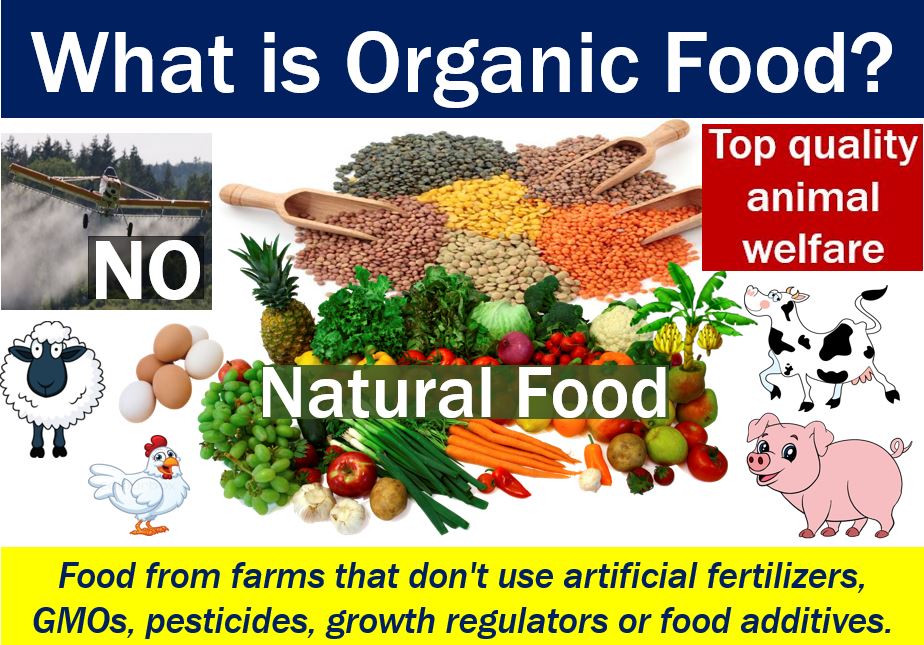Organic food – definition and meaning
Organic Food comes from an organic farm. Organic farms produce food as naturally as possible. They do not use artificial pesticides, fertilizers, livestock feed additives, or growth regulators. Neither do they irradiate their produce or use GMOs.
The letters ‘GMOs’ stand for Genetically Modified Organisms. Organic farmers do not routinely give their animals antibiotics.
The Soil Association says that organic farms also have the highest standards of animal welfare.
The Soil Association is a UK-based charity with more than 27,000 members. It campaigns against intensive farming and supports local purchasing and public education on nutrition. The Soil Association sends inspectors who determine whether farms are organic.
Inspectors visit organic farms at least once a year. If the farm does not get organic certification, it cannot claim that its products are organic.

A misconception
Many people believe that when you place the word “organic” next to any food, it means that its nutritional content is superior to other foods. They believe, for example, that an organic banana has more vitamins and minerals than other bananas. This is NOT the case. The word organic does not describe nutritional content.
Organic only refers to how the produce was farmed. Organic food has been cultivated without the use of pesticides, artificial fertilizers, genetically modified organisms (GMOs), growth hormones, or antibiotics. It adheres to certain standards of natural farming.
Organic food – the United States
The Economic Research Service says that consumer demand for organic food is growing rapidly in the US. Consumer demand is providing market incentives for American farmers across a broad range of products.
The Economic Research Service is part of the US Department of Agriculture (USDA).
Nearly three out of four conventional grocery stores in the US today sell organic foods. Organic products represent more than four percent of total American food sales.
American consumers purchase organic food either at natural food stores, conventional grocery stores, or direct-to-consumer markets.
In the US, as in the rest of the world, organic foods tend to be more expensive than other foods.
Organic farms began retailing products in the US over thirty years ago. Vegetables and fresh fruit have been the top-selling category throughout the whole period.
Organic food – UK market
In February 2017, an Organic Market Report informed that the UK organic market is worth £2.09 billion. In 2016, total sales of organic products grew by 7.1%, while non-organic food sales declined.
However, organic only represents about 1.5% of the total British food and drink market. In other words, it is still a tiny proportion of total sales.
However, more British shoppers are progressively opting for organic products. According to the Report, thirty-nine percent of consumers buy organic products at least once a week. Additionally, eighty percent of all shoppers said they had some knowledge about organic food.
The following highlights come from the UK Report. They all relate to organic foods and the market in 2016:
- Supermarket sales increased by 6.1%.
- Independent retailers reported growth in sales of 6.3%.
- Home delivery sales grew by 10.5%.
- Sales into the foodservice market increased by 19.1%.
- The organic wellbeing and beauty sector expanded by 13%. In fact, at the end of 2016, it was worth £61.2 million.
Supermarkets dominate the organic food market in Britain. Sixty-nine percent of all organic food sales occurred in supermarkets in the UK in 2016.
Even since online shopping emerged in the 1990s, home deliveries of organic foods have increased dramatically.
Video – What is organic food?
This video presentation, from our sister channel on YouTube – Marketing Business Network, explains what ‘Organic Food’ means using simple and easy-to-understand language and examples.

